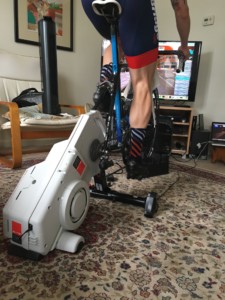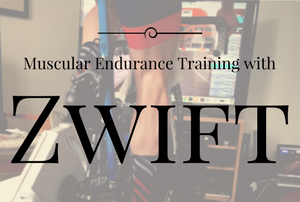Zwift has revolutionized the way we train indoors with a trainer. The emergence of smart trainers has turned Zwift into an immersive virtual riding experience. Muscular endurance (ME) is one of the basic fundamental skills that create a well-rounded cyclist, but it can be boring to accomplish on a trainer. Combining the two together provides you the opportunity to get tons of high-quality training and keep things from getting stale. But before you can go about building a ton of muscular endurance and making your body bulletproof, you have to understand what the goal of a ME interval is.
So, first of all, what is muscular endurance and why is it important?
Muscular endurance is your body's ability to resist muscular fatigue under pedaling tension. That pedaling tension is where the magic happens in your pedal stroke. The more tension in the pedals, the more power gets to the rear wheel and the faster you go. I'm sure you've experienced a time when you have to really dig in and push hard to catch your riding buddy. After a short time, your legs start to get heavy and tired and you have to rest. The more times you have to repeat this kind of move, the harder it becomes because your legs are just tired out. Maybe your legs cramp up or maybe you just can't make the move. No matter what the outcome, you just need more ME training in your program.
In this article I'm going to give you tips to improve your muscular endurance training with Zwift. Click through the jump to find out how:
 Muscular endurance with the Zwift workout builder
Muscular endurance with the Zwift workout builder
The Zwift workout builder makes building muscular endurance simple. The workout builder has the ability to design any workout you want, especially when you use the cadence option. Muscular endurance relies on a couple of conditions to be effective: the first of which is a specific cadence range. You should be aiming for a variety of cadences between 70 and 80 RPM. The second portion of a ME workout is the amount of pedal tension. You want your legs to be under near-constant tension throughout the interval.
You should aim for around 30-40 minutes of ME work as you start out. That can be broken up in pretty much any way you like, but intervals should be no shorter than 10 minutes or so. The harder the interval, the shorter it can be, and in many cases, people find that a sweetspot intensity is the perfect intensity level to get the most out of their muscular endurance intervals.
So go ahead and hit the workout builder. Just keep these tips in mind:
- Intervals should be a minimum of 10 minutes in length.
- Rest periods between intervals should be around 50% of the interval length.
- Do most of your intervals somewhere between 90% and 100% of your functional threshold power.
- Keep your cadences in the 70 to 80 RPM range.
If you're not sure about building your own workout in the Zwift workout builder, you can click this link to grab one that I've built. It's about an hour long and will give you a good muscular endurance challenge.
Muscular endurance in Zwift free ride mode
Zwift allows you to “just ride” without doing a structured workout. You should take advantage of these “free rides” to get some additional muscular endurance work built into your training time. You just need to know where to go about getting it.
Zwift has a number of courses available to ride, but perhaps the best one to get muscular endurance work done is the Watopia island course. The Watopia course has a long climb, on the order of around 25-30 minutes in length. That climb is the perfect way to get some muscular endurance work in (especially if you're using a smart trainer). Think about it for a minute: when you climb a hill outside, your cadence typically drops and the tension on the pedals increases. Sounds a lot like a muscular endurance interval, doesn't it?
How do you train muscular endurance on the mountain? When you're climbing up the Watopia mountain, gear up to a big gear and let your cadence drop. The high tension on the pedals and low cadence will simulate the incline on the mountain. You can vary your cadence and gearing to help create a wider variety of adaptations. Standing up out of the saddle while shifting to even harder gears will help you mimic changes in gradient and give you some additional pedal stroke technique work. This is especially true on a smart trainer, which will create varying amounts of resistance depending on the gradient on screen.
You can check out an example of muscular endurance work during Zwift free ride mode in this video:
Keep in mind that in the video I'm using an Elite Drivo smart trainer. If you're using a regular trainer like a Kurt Kinetic (my favorite non-smart trainer), you will need to use your gearing to mimic changes in terrain. This is because the trainer resistance is constant and doesn't change with the terrain. I highly suggest you do use the gearing to simulate different gradients, as it's closer to what riding outdoors is like.
Tips to get the most out of your muscular endurance work
If you want to get a little bit more out of your muscular endurance training, keep these tips in mind.
- During your muscular endurance intervals, focus on keeping tension even around the entire pedal stroke.
- Low cadence is the key here. Aim for 65-75 RPM on average. Sometimes, especially with a smart trainer, you'll find your cadence rising during flat sections. That's ok, it's just like riding outdoors.
- Intensity can be anywhere from sweetspot intensity up to functional threshold power level.
- If you're using a standard trainer, use your gearing to simulate changes in terrain. It will force you to change cadence, position and generally make you move around on the bike just like riding outdoors.
- Use the workout builder if you're not keen on doing your ME work in free ride mode or if you're just not disciplined enough. Either use the workout I provided you above or build your own ME workout.
Remember that these muscular endurance intervals are one of the keys to building a strong cycling base. The more time you put into building that solid base, the stronger your season will be. Like the foundation of a house, the stronger the foundation, the stronger the structure on top of that foundation will be. So, the more time you're able to spend on your functional base, the stronger your fitness can be overall.
Hopefully, these tips will give you the ability to add some extra, high-quality muscular endurance work to your program. If you have any questions, don't hesitate to contact me and I'll help you out with them.
